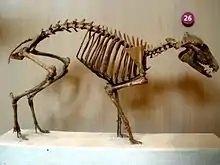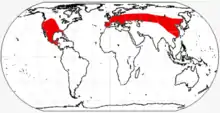Hypertragulidae
Hypertragulidae is an extinct family of artiodactyl ungulates that lived in North America, Europe, and Asia from the Eocene until the Miocene, living 46.2—13.6 million years ago, existing for about 33 million years.[1]
| Hypertragulidae | |
|---|---|
 | |
| Hypertragulus | |
| Scientific classification | |
| Kingdom: | Animalia |
| Phylum: | Chordata |
| Class: | Mammalia |
| Order: | Artiodactyla |
| Family: | †Hypertragulidae Cope, 1879 |
| Genera | |
| |
 | |
| Range of Hypertragulidae based on fossil finds | |
The Hypertragulidae are basal ruminants that resembled small deer or musk deer in life. However, neither deer, nor musk deer are considered to be closely related to the hypertragulids. Instead, the chevrotains are probably the closest living relatives to these ancient deer-like animals.
Taxonomy
Hypertragulidae was named by Cope (1879). This family was considered paraphyletic by Matthew (1908). It was assigned to Ruminantia by Matthew (1908) and Gregory (1910); to Pecora by Cook (1934); and to Traguloidea by Carroll (1988).[2][3][4]
Morphology
Hypertragulidae have tetradactyl front feet and didactyl rear feet, which is specific to this family and no other ruminants. They ranged in body mass from as small as 2.16 kg (4.8 lb) with Parvitragulus to as large as 4.24 kg (9.3 lb) in Hypisodus.
References
- PaleoBiology Database: Hypertragulidae, basic info
- W. D. Matthew. 1908. Osteology of Blastomeryx and phylogeny of the American Cervidae. Bulletin of the American Museum of Natural History 24(27):535-562
- W. K. Gregory. 1910. The orders of mammals. Bulletin of the American Museum of Natural History 27:1-524
- H. J. Cook. 1934. New artiodactyls from the Oligocene and Lower Miocene of Nebraska. American Midland Naturalist 15(2):148-165
